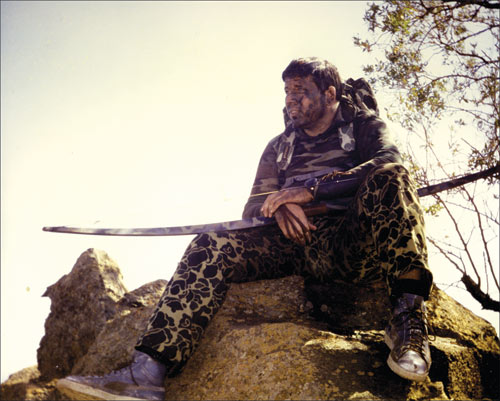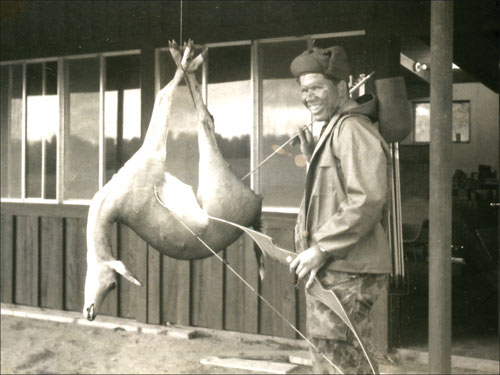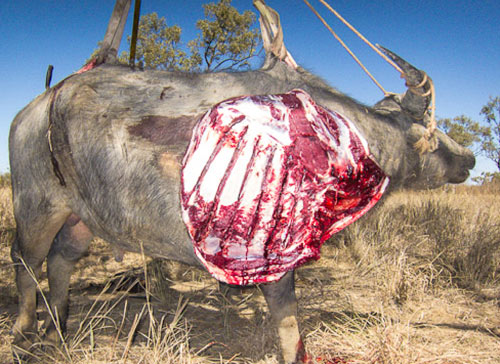By Dr. Ed Ashby – Re-published courtesy of Grizzly Stik
The hit looked good. After a short wait, the blind was abandoned and the blood trail located. Drop by drop the trail was followed, but the trophy was never found.
For the last thirty‑eight years, I have bowhunted big game. I have heard countless versions of this scenario. Sadly, it is more common now than when I first started. In Part II of this series, we examined some of the results of the Natal Study. In Part III we will look at the development of much of today’s equipment from a historical perspective framed by the information from the study.
Some of the information presented here is a summary of information presented in Part II. Here it is presented in a more ‘readable’ form, without the technical supporting data.
The selection of the broadhead and arrow one hunts with is the key ‘secret’ in converting hits into kills. Next to hunting skills, it is the biggest determinant of bowhunting success.
When I began bowhunting, there were only a few commercial broadheads. All were rigid broadheads, based on designs centuries old. The majority were single blade heads. Some were small three-blade heads. Few were of other designs.
Only a handful of contemporary bowhunters had ever taken ‘big’ animals. Pope and Young had taken Grizzly and Brown Bear, Lion and Cape Buffalo. Howard Hill had taken an impressive array, including Elk, Moose, Bears, Bison, Lion, Leopard, Cape Buffalo, and Elephant. Bob Sweinhart took all of Africa’s big five. Soon, Ben Pearson took a Polar Bear. Fred Bear took Brown and Polar Bear. Then Fred ventured to Africa, taking Lion, Cape Buffalo and Elephant.
All of these hunters, except Fred, had used conventional single blade broadheads. Fred used his original “Razorhead.” It was a single blade head but with a small ‘bleeder blade’ insert. The bleeder blade was made of a hard, brittle, carbon steel, similar to the old ‘blue steel’ razor blades, hence the name.
Fred often said, “The purpose of the bleeder blade is to open a larger hole in the skin on entrance. It’s designed to break on impact with any firm resistance. The main blade carries on, working like any other broadhead.” Fred felt that opening a large entrance hole reduced the drag on the arrow shaft, giving better penetration. He felt it also gave a better blood trail. The purpose of the bleeder blade was not to increase the cut area of the broadhead, not to make it a ‘multiblade’ broadhead.
Still, the Razorhead was responsible for ushering in a whole new era in broadhead design — the multiblade broadhead. They were touted as offering ‘increased cutting area’. They did cut a larger hole, but the increased tissue resistance of the multiple blades resulted in less penetration. The rigid multiblade head was closely followed by the ‘replaceable blade head’. These featured multiple blades of thin stainless steel, attached to a steel, alloy, nylon or polymer resin ‘body’.
Their blades were designed, not to shatter, but to remain intact. They were to be replaced after each shot, negating the need to resharpen. Like their rigid predecessors, they offered increased cut area, but at the cost of increased tissue resistance.
It soon became difficult to find quality single blade broadheads. Ben Pearson’s fine Deadhead fell by the wayside. Only the Black Diamond and the Howard Hill broadhead could be located in archery suppliers inventory. I, and many others, soon discovered that no multiblade broadhead penetrated bone well. The resistance was simply too great.
The replaceable blade models often broke when bone was hit. Even when they did penetrate, they tended to bend, often shedding blades in the process. Blades which survived were nicked, bent and severely dulled. The thin blades were often damaged even when no bone was hit.
Concurrent with the arrival and widespread use of these broadheads, numerous researchers noted an increase in the number of animals being hit and not killed. But these broadheads were not the only factor contributing to the increase in lost animals.
Coinciding with their proliferation was the development of the compound bow. It’s contribution to wounding was not a direct result of its design but was simply a by-product. The compound bow’s ‘let off’ produced a less violent thrust to the arrow shaft. Compound shooters soon discovered that lighter arrows could be used with the compound bow. The lighter arrows resulted in increased arrow speed and flatter trajectory. The flatter trajectory made it easier to hit an animal. But the lighter arrows caused a loss of momentum. This reduced penetration.
I have no intent to degrade the compound bow. It is an engineering marvel, capable of transmitting more energy to an arrow, of a given weight, than any equivalent conventional bow. It has opened the joys of bowhunting to many who are not able to learn to shoot a conventional bow of adequate weight for big game hunting.
The problem came in the misuse of the compound bow’s available energy. Instead of using the extra energy for increased arrow momentum, many bowhunters chose to use lighter arrows in order to get higher arrow speeds. Speed was in vogue. Arrow shaft materials became ever lighter. Broadhead manufacturers made ever lighter, and more fragile, broadheads. The use of thin replaceable blades became the norm.
In the search for even more speed, overdraw bows became common in the hunting field. They made it possible to use shorter, still lighter, arrows. Some as light as 300 grains were being used. Arrow momentum was drastically reduced. Combined with the tissue resistance of the multiple blades, penetration was greatly reduced, and wounding became a common occurrence.
Lets now look again at the facts which emerged from the study of killing and non-killing hits on real animals in the Natal Study. The facts are: There is a direct correlation between the depth of arrow penetration and percentage of killing hits. The deeper an arrow penetrates, the more likely it is to kill. There is no correlation between broadhead size, number of blades or ‘cut area’ and the percentage of killing hits.
Given a well placed hit with a sharp broadhead, broadhead failure and inadequate penetration are the only two things which cause failure to kill. Broadheads must remain undamaged. Many broadheads are fragile, bending or breaking on impact with even light bone. A rigid single blade broadhead is the least likely to be bent or broken. A broadhead which is damaged gives an inadequate performance. It frequently fails to penetrate well. It frequently fails to kill.
Replaceable blade heads are four times more likely to be damaged than a rigid single blade head. Rigid multiblade heads are over three times more likely to be damaged than rigid single blade heads. Single blade heads penetrate both soft tissues and bone better than any multiblade head. This holds true regardless of the presence or absence of any ‘bone breaker’ tip.
When a bone is hit, heads with four, or five blades penetrate better than heads with three blades. Where only soft tissue is hit, three-blade heads out-penetrate those with four, or more, blades. Neither penetrates as well as a single blade head.
Single blade broadheads hitting the spine have a ‘kill rate’ of over 80 percent. Multiblade heads, whether replaceable blade or rigid, scored a 0 percent kill rate for spine hits. (There were roughly an equal number of spine hits with each type of broadhead).
When a rib is hit on entrance, a single blade broadhead is three times more likely to kill than a three‑blade head. It is twice as likely to kill as a head with four, or more, blades. On a broadside shot hitting the shoulder blade, a single blade head is three times more likely to kill than any multiblade head.
Single blade broadheads are more than twice as likely to produce an exit wound as a multiblade broadhead. This results in a better blood trail, particularly if the entrance wound is high, as in a shot taken from a tree stand.
When a sharp broadhead remains intact on a well-placed hit, failure to kill is due to inadequate arrow penetration. Taking all hit placements, arrows with single blade heads average 41 percent more penetration than three blade heads and 34 percent more than four blade heads.
Those are the hard, cold, facts. They are actual measurements from a large number of hits on real animals.
Good single blade broadheads out-perform multiblade heads under all conditions, with one possible exception: a gut shot. I say ‘possible’ because I simply don’t have enough data on gut shots to say for sure.
Fortunately, there has been a resurgence in ‘traditional’ archery in the last decade. A number of major manufacturers now feature traditional equipment in their product lines.
With this renewed interest in traditional archery came a revival of the single blade broadhead. Along with the Black Diamond and the Hill broadhead, both of which never ceased production, there are now many others available. Some of the finest single blade broadheads ever made are available to today’s bowhunter.
Just what is a ‘good’ single blade broadhead? I have several criteria. The blade must have reasonable metal thickness. It must be of good quality steel, neither bending nor breaking when hard bone is hit. I prefer carbon steel with a Rockwell hardness from 49 to 55. It is still sharpenable with file or stone. It will break before it will bend and, if of reasonable thickness, it’s awfully hard to break.
I prefer a broadhead which is long and narrow in shape. Both Hill and Sweinhart felt that a single blade broadhead 3″ long and 1″ wide offered the best penetration. Pope and Young used heads of similar dimensions.
The longer the cutting blade for any given width, the better, so long as the rigidity of the head is maintained. As we shall see in Part IV, the ratio of length to width is important in using arrow momentum for maximum penetration.
The ferrule should taper long and smooth into the blade, with no abrupt junctures. Just as with the blade, the longer the ferrule’s taper, the better it uses arrow momentum, and the deeper it penetrates.
My favourite broadhead is the 190 grain Grizzly. I routinely narrow these to one inch (or less) cutting width. The length is left at three and one-quarter inches.
Next to broadhead design, total arrow weight and shaft diameter are the most important features in penetration. Pope and Young recommended ten grains of arrow weight for each pound of bow draw weight. For the heavy bows they used, they weren’t far off.
The figures on arrow weight are less conclusive than for broadheads. It is difficult to get enough facts to reach definite answers. To be valid, all the shots must use the same broadhead, shaft diameter and momentum, but be with arrows of different weight. What information is available suggests that minimum arrow weight should be at least 650 grains for ‘standard’ big game animals. With a strong broadhead, this normally gives enough penetration when bone is hit.
My standard hunting arrow is 785 grains. The shafts are of compressed cedar. I have nothing against the more modern shaft materials. They just don’t have sufficient spine and weight in a shaft diameter as small as I want, and I will get to shaft diameter in a moment.
I can get the desired weight, stiffness and diameter with ‘modern’ shaft materials by using double, or triple, shafts (one shaft inside another). It is a device I have used when making ‘super heavy’ arrows for the biggest of animals.
On the truly big animals, I find that an arrow weight of 900+ grains is required, with a small diameter shaft, to consistently get enough penetration — even when using modified broadheads and conventional bows from ninety to well over a hundred pounds draw weight.
Shaft diameter is the other important factor in penetration. When broadhead and momentum are equal, a shaft larger than the broadhead ferrule gives 33 percent less penetration than one equaling the ferrule’s diameter. It will penetrate 40 percent less than one with a shaft smaller than the broadhead ferrule. My shafts are slightly smaller in diameter than the ferrule of the broadheads I use.
So how can you judge if your broadheads and hunting arrows give adequate performance? Here are two tests I can recommend. They apply to all animals up to, but not including, the ‘super big’. Every reliable killing combination I have tested could pass them.
(1) You should consistently get total penetration on broadside chest shots (an exit wound). (2) Your arrows should be able to consistently penetrate through the shoulder blade and several inches into the thorax, with broadhead undamaged.
Broadheads and arrows for the ‘super big’ animals are an entirely different subject, as is hunting them. For what it is worth, my goal on BIG animals is consistent penetration to the fletching on chest shots, with broadheads remaining undamaged.
If you want to turn your hits into kills, my advice is: Use any bow you like, compound, recurve or longbow. Hunt with the heaviest draw weight bow you can handle (and ‘handle’ is the key word here).
Select a quality single blade broadhead of a long and narrow shape. Mount it on as heavy a shaft, of as small a diameter, as your bow will shoot with reasonable trajectory. As we shall see in Part IV: The Physics of Arrow Penetration, extra arrow mass does a lot to offset lower bow draw weight or arrow velocity. Use a minimum of 650 grains total arrow weight for most big animals and 900 grains if after the ‘super big’ animals. Don’t worry about arrow speed. Practice until you can place your arrows in the ‘kill zone’ at the range you intend to shoot. Study your quarry’s habits and practice your hunting skills. The heavier arrows do cost you some ‘range’. Get close to your game before shooting. Get your broadheads really sharp.
That, in total, is my personal formula. It usually results in finding the quarry, quite dead, at the end of a rather short blood trail. Is it 100 percent effective? Almost. Out of several hundred animals hit with such an arrow and broadhead, only two failed to end up hanging in my camp.
One was a Minnesota black bear. Within 20 yards of where it was hit, it plunged over a steep bank and into a dense cedar swamp with chest deep water. I never located him. The other was a mule deer. The blood trail ended, just five feet from a ‘Jeep trail’, in a puddle of blood, a ‘body print’, tire tracks and human footprints. He ended up in someone else’s freezer!
In the next installment of this series, we will examine the physical laws which govern arrow penetration, assuming one uses those good broadheads that will remain undamaged!
Copyright 1996 Dr. W.E (Ed) Ashby





